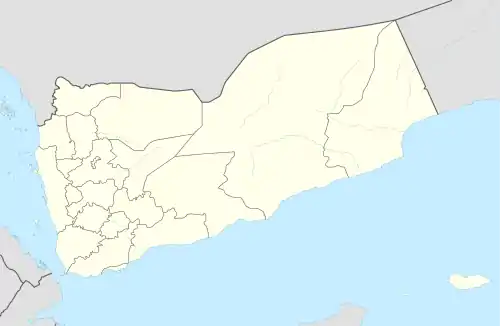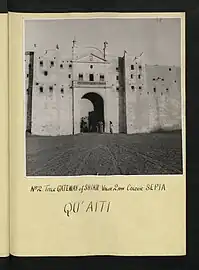Al-Shihr
Al-Shihr (Arabic: ٱلشِّحْر, romanized: al-Shiḥr), also known as ash-Shir or simply Shihr,[1] is a coastal town in Hadhramaut, eastern Yemen.[2]
al-Shihr
ٱلشِّحْر | |
|---|---|
Town | |
 Camels on the beach at al-Shihr | |
 al-Shihr Location in Yemen | |
| Coordinates: 14°45′39″N 49°36′25″E | |
| Country | |
| Governorate | Hadhramaut |
| District | al-Shihr |
| Time zone | UTC+3 (Yemen Standard Time) |
Al-Shihr is a walled town located on a sandy beach. There is an anchorage but no docks; boats are used. The main export is fish oil. The town is divided in two by a wādi (dry riverbed) called al-Misyāl. The western quarter is called Majraf and the eastern al-Ramla. As of 1997 it had several souqs (markets): the Sūq al-Lakham, Sūq al-Hunūd, Sūq Shibām, etc.[3]
History


The history of ash-Shihr (formerly also al-Asʿāʾ[4]) can be traced back as far as about AD 780.[4] It was a major port on the incense trade route as an exporter of frankincense to places as far as China.[1] Ibn Khurradādhbih calls the area around al-Shihr the bilād al-kundur, Land of Incense.[3] It was also known for its ambergris, ʿanbar Shiḥrī.[3] It was the main port of Hadhramaut until replaced by Mukalla in the 19th century.[3]
Local pottery production at Yadhghat was exported through al-Shihr, possibly as early as the 10th century. In 980, the entrepôt of Sharma was founded by Persian exiles up the coast from al-Shihr.[5] These rival ports are mentioned together in works of medieval Islamic geography. Writing in 985, al-Muqaddasī records that Sharma and ah-Shihr were dependencies of the Ziyadid dynasty. About 1150, al-Idrīsī wrote that Sharma and al-Shihr were stopovers on the sailing route from Aden to Mirbāṭ and were about one day apart. Around 1300, al-Dimashqī noted that Sharma and al-Shiḥr were the two harbors of Hadhramaut.[6] Al-Shihr is also mentioned by Ibn Khaldun in his al-Muqaddimah.[7]
Politically, al-Shihr has been under the Ziyadids (818–981), the Banū Maʿn (11th century), the Rasulids (1228–1454) and the Tahirids. After a short time, the latter lost it to the sultanate of Kathiri under Badr ibn Tuwayriq in 1462. In the 16th century, it was attacked several times by the Portuguese, who called it Xaer or Xael.[3] There were battles in 1523, 1532, 1533, and 1548.[8] There are still graves along the shore said to be of victims of the Portuguese.[3]
In 1530 Mustafa Bey and Khoja Zufar arrived at the port of al-Shihr in Yemen.[9] The Ottomans advised the Sultan of al-Shihr, Badr, to not submit to the Portuguese and left cannons and 100 levends with the Sultan of al-Shihr.[9] Mustafa Bey left al-Shihr in December 1530 while Khoja Zufar remained with Badr.[9] A Portuguese force of 9 sails led by Manoel de Vasconcellos immediately arrived at the port of al-Shihr, however, Khoja Zufar prevented the Portuguese from entering al-Shihr.[10][11][12][13][14][15]
Later, al-Shihr became one of the three major cities of the Qu'aiti Sultanate, before a unified Yemen was formed, the other two being Mukalla and Shibam.[2]
Carsten Niebuhr visited al-Shihr in the 18th century.[3]
Yemenis who emigrated to East Africa and their descendants are known as Shihiris, because most of them moved through the port of al-Shihr.[3]
See also
References
- Kauz, Ralph (2010). Schottenhammer, Angela (ed.). Aspects of the Maritime Silk Road: From the Persian Gulf to the East China Sea. Vol. 10 of East Asian Economic and Socio-cultural Studies - East Asian Maritime History. Otto Harrassowitz Verlag. p. 130. ISBN 978-3-447-06103-2. Retrieved December 26, 2011.
- McLaughlin, Daniel (2008). "10: Southeast Yemen". Yemen. Bradt Travel Guides. pp. 191–198. ISBN 978-1-8416-2212-5.
- G. R. Smith (1997). "al-Shiḥr". In Bosworth, C. E.; van Donzel, E.; Heinrichs, W. P. & Lecomte, G. (eds.). Encyclopaedia of Islam. Volume IX: San–Sze (2nd ed.). Leiden: E. J. Brill. pp. 438–439. ISBN 978-90-04-10422-8.
- Claire Hardy‐Guilbert; Sterenn Le Maguer (2010), "Chihr de l'encens (Yémen)" (PDF), Arabian Archaeology and Epigraphy, 21 (1): 46–70, doi:10.1111/j.1600-0471.2009.00322.x, at 47.
- Axelle Rougeulle (2007), "Ceramic Production in Medieval Yemen: The Yadhghat Kiln Site", Proceedings of the Seminar for Arabian Studies: 239–252.
- Axelle Rougeulle (2003), "Excavations at Sharmah, Ḥaḍramawt: The 2001 and 2002 Seasons", Proceedings of the Seminar for Arabian Studies, 33: 287–307, JSTOR 41223770, p. 287.
- Ibn Khaldun (1967). N.J. Dawood (ed.). The Muqaddimah: an Introduction to History. Vol. 1. Translated by Franz Rosenthal (2 ed.). Princeton, N.J.: Princeton University Press. pp. 122, 124, 126–7. OCLC 750556436.
- R.B.Serjeant, The Portuguese Off the South Arabian Coast: Ḥaḍramī Chronicles, with Yemeni and European Accounts of Dutch Pirates Off Mocha in the Seventeenth Century, 1963, Clarendon Press, p. 52, 57, 63, 67 and 108
- Öztuna, Yılmaz. Kanuni Sultan Süleyman. Turkey: Kültür Bakanlığı, 1989
- Andreu Martínez d’Alòs-Moner; Conquistadores, Mercenaries, and Missionaries: The Failed Portuguese Dominion of the Red Sea. Northeast African Studies 1 April 2012; 12 (1): 1–28. p.9.
- Tarih Enstitüsü dergisi. Turkey: İstanbul Üniversitesi, Edebiyat Fakültesi, Tarih Enstitüsü, 1974.
- Önalp, Ertuğrul. Osmanlının güney seferleri: XVI. yüzyılda Hint okyanusu'nda Türk-Portekiz mücadelesi. Turkey: Berikan Yayınevi, 2010.
- Mughul, Muhammad Yakub. Kanunî devri: Osmanlıların Hint Okyanusu politikası ve Osmanlı-Hint Müslümanları münasebetlerı, 1517-1538. Turkey: Fetih Yayınevi, 1974.
- R.B.Serjeant, The Portuguese Off the South Arabian Coast: Ḥaḍramī Chronicles, with Yemeni and European Accounts of Dutch Pirates Off Mocha in the Seventeenth Century, 1963, Clarendon Press, p. 57
- ابن حميد الكندي, العدّة المفيدة الجامعة لتواريخ قديمة وحديثة مكتبة الإرشاد، صنعاء عام 1991م, صفحة 168
Further reading
- Serjeant, R. B. "The Ports of Aden and Shihr (Mediaeval period)". Recueils de la Société Jean Bodin 32 (1974): 207–224.